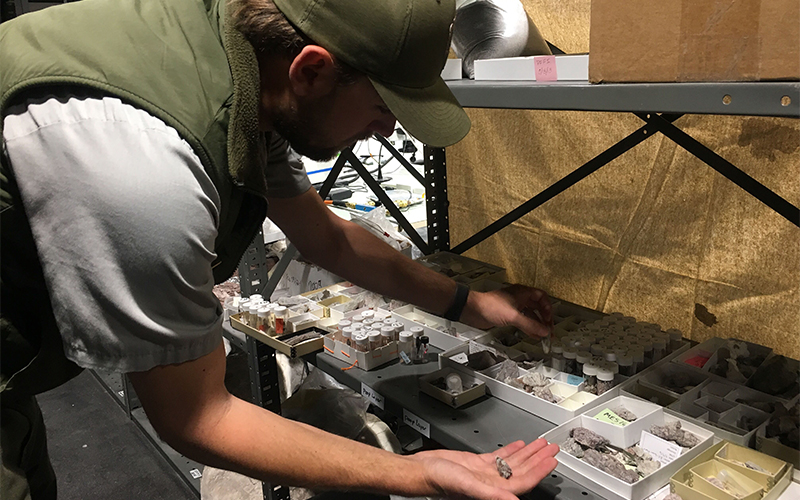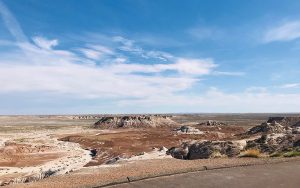
This is an artist’s rendition of what a Triassic frog may have looked like. Paleontologists last May discovered a tiny pelvic bone from a frog dating to this time period. They plan to return to Petrified Forest National Park in June to search for more such fossils. (Image courtesy of Andrey Atuchin)

Adam Marsh, lead paleontologist at the Petrified Forest National Park, discovered the oldest fossil frogs in North America. (Photo by Adrian Marsh/Cronkite News)

Phytosaur teeth are just a few of the many fossils Adam Marsh has in the research lab at the Petrified Forest National Park. (Photo by Adrian Marsh/Cronkite News)
PETRIFIED FOREST – Adam Marsh and Michelle Stocker had been out all day in the hot weather, breaking rocks and sifting through the pieces, when they made a major discovery last May.

Paleontologists discovered fragments of fossilized frogs in the Chinle Formation at Petrified Forest National Park and the surrounding area. That puts the fossils in the late Triassic period, a time 200 million years ago when this area supported rivers and lakes. (Photo by Peter Gong/Cronkite News)
“What we saw under the magnifying glass was something that looked a lot like a fossil frog pelvis,” said Marsh, the lead paleontologist at Petrified Forest National Park in northern Arizona where the discovery was made.
The tiny pelvic bone is no larger than a pinky nail. Fossilized fragments also were found at a nearby ranch and a stone quarry near St. Johns.
Researchers don’t know whether the frogs underwent metamorphosis like modern frogs, Marsh said. Because so few fragments were discovered, it’s hard to say what the frogs actually looked like – or whether they hopped.
Marsh said the fossils reveal an important fact: Frogs survived a mass extinction in the Triassic period.
Stocker, an assistant professor at Virginia Tech, said their discovery fills in a gap in the timeline for the Triassic. Paleontologist only had records from the early Triassic that are about 250 million years old.
“The purpose of it (finding fossils) is more that we’re trying to understand biodiversity on earth,” Stocker said. “And you can’t just look at the animals that are alive today.”
The biggest challenge was finding the fossil in the first place, she said.
“We look for bones and jaws and teeth and things like that that might be preserved in those layers that way,” Stocker said. “This part of the frog, that hip bone that we found, is really distinctive for the group.”
Stocker and Marsh found the fossil by washing the rocks through metal screens, then using a microscope to determine what was in the rock.
The fragments were discovered in the Chinle Formation, rocks that were deposited more than 200 million years ago, putting the frogs in the late Triassic period, a time when the area supported rivers and lakes rather than the desert seen today.
“So they’re (the frogs) living in somewhat wet environments,” Marsh said. “In the Triassic here in Arizona, all the rocks are deposited by rivers, lakes, streams.”
Sharks, reptiles and other creatures lived along with the frogs, he said.
Marsh and Stocker plan to return to the park in early June to hunt for more fossils.
AlertMe